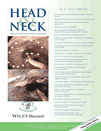Method to help ensure survival of a very small skin paddle of pectoralis major musculocutaneous flap in head and neck reconstruction
Abstract
Background
When the required dimension of skin paddle of a pectoralis major musculocutaneous (PMMC) flap is very small, its survival often becomes questionable. We introduce a simple technique which enlarges the practical dimension of a very small skin paddle, leading to ensure the survival of a PMMC flap.
Method and Result
A PMMC flap size of 1.5 × 4 cm was required for repair of leakage which developed 2 weeks after the primary ablative surgery for hypopharyngeal cancer. The skin paddle was designed in the size of 4.5 × 7 cm and was deepithelized except the original dimension. After the skin edge was sutured to the defect margin, the deepithelized dermal portion covered the repair site to enhance the suture.
Conclusion
The effective dimension of a very small skin paddle can be quite enlarged thus increasing the possibility of capturing perforators. This could decrease the risk of avulsion during flap transfer and provide backing of the repair site. © 2012 Wiley Periodicals, Inc. Head Neck, 2013




